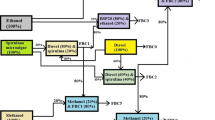Abstract
The effect of the addition of different proportions of silver (Ag) nanoparticles and alcohols in milk scum oil methyl ester on the performance of engine and emission are studied. B20 blend is added with 5% of ethanol, n-butanol, and iso-butanol as ternary additives for the experimental analysis from no load to full load. Furthermore, at a fixed load, operating conditions such as injection pressure (12 and 15 bar) and injection timing (23° and 26°) are varied without and with the addition of 0.8 vol% of Ag (silver) nanoparticles to the fuel blends. Also, the concentrations of Ag nanoparticles are increased from 0.2 to 1 vol% and comparisons are made with diesel and B60 blend. Mathematical models are developed for selected features of engine performance which fits with the experimental values for the purpose of optimization using the Dragon fly algorithm (DA) by considering these models as the objective functions. The concentration of nanoparticles lowers the BSFC significantly and helps in reducing the emission with an increased percentage. Using full biodiesel, 16.6% reduction in BTE was obtained, while use of alcohols prevented this reduction approximately by 5%. A highest of 4.6% improvement was obtained with the addition of Ag nanoparticles. 4.5% reduction in HC and 13% in NOx emission using nanoparticles are obtained. The DA algorithm provided the same optimized value at the end of 30 iterations in different cycles of execution. Nanoparticle addition and use of pressure in the range of 20 bar gives the lowest emission from the engine.




















Similar content being viewed by others
References
Abas N, Kalair A, Khan N (2015) Review of fossil fuels and future energy technologies. Futures 69:31–49. https://doi.org/10.1016/J.FUTURES.2015.03.003
Agarwal AK (2007) Biofuels (alcohols and biodiesel) applications as fuels for internal combustion engines. Prog Energy Combust Sci 33(3):233–271
Ahluwalia IJ, Patel U (2018) Working Paper No. 356. Solid Waste Management in India An Assessment of Resource Recovery and Environmental Impact. Indian Council for Research on International Economic Relations. https://icrier.org/pdf/Working_Paper_356.pdf
Ali Y, Eskridge KM, Hanna MA (1995) Testing of alternative diesel fuel from tallow and soybean oil in Cummins N14–410 diesel engine. Biores Technol 53(3):243–254. https://doi.org/10.1016/0960-8524(95)00092-S
Ashok B, Nanthagopal K, Subbarao R, Johny A, Mohan A, Tamilarasu A (2017) Experimental studies on the effect of metal oxide and antioxidant additives with Calophyllum Inophyllum methyl ester in compression ignition engine. J Clean Prod 166:474–484
Atmanli A, Yilmaz N (2018) A comparative analysis of n-butanol/diesel and 1-pentanol/diesel blends in a compression ignition engine. Fuel 234:161–169
Babu D, Anand R (2017) Effect of biodiesel-diesel-n-pentanol and biodiesel–diesel–n-hexanol blends on diesel engine emission and combustion characteristics. Energy 133:761–776
Balaji G, Cheralathan M (2014) Study of antioxidant effect on oxidation stability and emissions in a methyl ester of neem oil fuelled DI diesel engine. J Energy Inst 87(3):188–195
Balan KN, Yashvanth U, Booma Devi P, Arvind T, Nelson H, Devarajan Y (2019) Investigation on emission characteristics of alcohol biodiesel blended diesel engine. Energy Sources A Recover Util Environ Eff 41(15):1879–1889
Devarajan Y, Munuswamy DB, Mahalingam A (2018) Influence of nano-additive on performance and emission characteristics of a diesel engine running on neat neem oil biodiesel. Environ Sci Pollut Res 25(26):26167–26172
Devarajan Y, Choubey G, Mehar K (2019) Ignition analysis on neat alcohols and biodiesel blends propelled research compression ignition engine. Energy Sources A Recover Util Environ Eff 42:1–12
Elahi M et al (2019) The effects of graphene oxide nanoparticle additive stably dispersed in dairy scum oil biodiesel–diesel fuel blend on CI engine: performance, emission and combustion characteristics. Fuel 257:116015. https://doi.org/10.1016/j.fuel.2019.116015
El-Seesy AI, Attia AMA, El-Batsh HM (2018) The effect of Aluminum oxide nanoparticles addition with Jojoba methyl ester–diesel fuel blend on a diesel engine performance, combustion and emission characteristics. Fuel 224:147–166
Fazelian N, Yousefzadi M, Movafeghi A (2020) Algal response to metal oxide nanoparticles: analysis of growth, protein content, and fatty acid composition. Bioenergy Res 13:944–954
Fernández-Dacosta C, Shen L, Schakel W, Ramirez A, Kramer GJ (2019) Potential and challenges of low-carbon energy options: comparative assessment of alternative fuels for the transport sector. Appl Energy 236:590–606
Gavhane RS et al (2020) Effect of zinc oxide nano-additives and soybean biodiesel at varying loads and compression ratios on vcr diesel engine characteristics. Symmetry (basel) 12(6):1042
Gebremariam SN, Marchetti JM (2018) Economics of biodiesel production. Energy Convers Manage 168:74–84
Ghanbari F et al (2017) Mitochondrial oxidative stress and dysfunction induced by single-and multiwall carbon nanotubes: a comparative study. J Biomed Mater Res A 105(7):2047–2055
Goga G, Singh BC, Kumar SM, Muk HC (2019) Performance and emission characteristics of diesel engine fueled with rice bran biodiesel and n-butanol. Energy Rep 5:78–83. https://doi.org/10.1016/j.egyr.2018.12.002
Grana R et al (2010) An experimental and kinetic modeling study of combustion of isomers of butanol. Combust Flame 157(11):2137–2154
Höök M, Tang X (2013) Depletion of fossil fuels and anthropogenic climate change—a review. Energy Policy 52:797–809
Hosseinzadeh-bandbafha H, Khalife E, Tabatabaei M (2019) Effects of aqueous carbon nanoparticles as a novel nanoadditive in water-emulsified diesel/biodiesel blends on performance and emissions parameters of a diesel engine. Energy Convers Manag 196:1153–1166. https://doi.org/10.1016/j.enconman.2019.06.077
Jha SK et al (2009) A comparative study of exhaust emissions using diesel-biodiesel-ethanol blends in new and used engines. Trans ASABE 52(2):375–381. https://doi.org/10.13031/2013.26821
Jin C, Yao M, Liu H, Chia-fon FL, Ji J (2011) Progress in the production and application of n-butanol as a biofuel. Renew Sustain Energy Rev 15(8):4080–4106
Johnsson F, Kjärstad J, Rootzén J (2019) The threat to climate change mitigation posed by the abundance of fossil fuels. Clim Policy 19(2):258–274
Kannaiyan K, Sadr R (2017) The effects of alumina nanoparticles as fuel additives on the spray characteristics of gas-to-liquid jet fuels. Exp Therm Fluid Sci 87:93–103
Kannan GR, Karvembu R, Anand R (2011) Effect of metal based additive on performance emission and combustion characteristics of diesel engine fuelled with biodiesel. Appl Energy 88(11):3694–3703
Khan H et al (2020) Effect of nano-graphene oxide and n-butanol fuel additives blended with diesel—Nigella sativa biodiesel fuel emulsion on diesel engine characteristics. Symmetry (basel) 12(6):961
Killol A, Reddy N, Paruvada S, Murugan S (2019) Experimental studies of a diesel engine run on biodiesel n-butanol blends. Renew Energy 135:687–700
Li Y, Tang W, Chen Y, Liu J, Chia-fon FL (2019) Potential of acetone-butanol-ethanol (ABE) as a biofuel. Fuel 242:673–686
Martínez-Ruano JA, Restrepo-Serna DL, Carmona-Garcia E, Giraldo JAP, Aroca G, Cardona CA (2019) Effect of co-digestion of milk-whey and potato stem on heat and power generation using biogas as an energy vector: techno-economic assessment. Appl Energy 241:504–518
Mat Yasin MH, Yusaf T, Mamat R, Fitri Yusop A (2014) Characterization of a diesel engine operating with a small proportion of methanol as a fuel additive in biodiesel blend. Appl Energy 114:865–873. https://doi.org/10.1016/j.apenergy.2013.06.012
Mehregan M, Moghiman M (2020) Experimental investigation of the distinct effects of nanoparticles addition and urea-SCR after-treatment system on NOx emissions in a blended-biodiesel fueled internal combustion engine. Fuel 262:116609
Mirjalili S (2016) Dragonfly algorithm: a new meta-heuristic optimization technique for solving single-objective, discrete, and multi-objective problems. Neural Comput Appl 27(4):1053–1073. https://doi.org/10.1007/s00521-015-1920-1
Mujtaba MA et al (2020) Comparative study of nanoparticles and alcoholic fuel additives–biodiesel–diesel blend for performance and emission improvements. Fuel 279:118434
Nanthagopal K, Ashok B, Saravanan B, Patel D, Sudarshan B, Aaditya Ramasamy R (2017a) An assessment on the effects of 1-pentanol and 1-butanol as additives with Calophyllum Inophyllum biodiesel. Energy Convers Manage 158:70–80. https://doi.org/10.1016/j.enconman.2017.12.048
Nanthagopal K, Ashok B, Varatharajan V, Anand V, Kumar RD (2017b) Study on the effect of exhaust gas-based fuel preheating device on ethanol–diesel blends operation in a compression ignition engine. Clean Technol Environ Policy 19(10):2379–2392
Nanthagopal K, Kishna RS, Atabani AE, Alaa H, Kumar G, Ashok B (2020) A compressive review on the effects of alcohols and nanoparticles as an oxygenated enhancer in compression ignition engine. Energy Convers Manage 203:112244
Ojha PK, Maji R, Karmakar S (2018) Effect of crystallinity on droplet regression and disruptive burning characteristics of nanofuel droplets containing amorphous and crystalline boron nanoparticles. Combust Flame 188:412–427
Raheman H, Phadatare AG (2004) Diesel engine emissions and performance from blends of karanja methyl ester and diesel. Biomass Bioenerg 27(4):393–397. https://doi.org/10.1016/J.BIOMBIOE.2004.03.002
Rajesh Kumar B et al (2016) A comparative analysis on combustion and emissions of some next generation higher-alcohol/diesel blends in a direct-injection diesel engine. Energy Convers Manage 119:246–256. https://doi.org/10.1016/j.enconman.2016.04.053
Raman LA, Deepanraj B, Rajakumar S, Sivasubramanian V (2018) Experimental investigation on performance, combustion and emission analysis of a direct injection diesel engine fuelled with rapeseed oil biodiesel. Fuel 246:69–74. https://doi.org/10.1016/j.fuel.2019.02.106
Singh V, Agarwal T, Saroha N, Gautam R (2019) Performance emissions and combustion analysis of CI engine using ethyl ester kusum oil and butanol blends. SAE technical paper
Soudagar MEM, Kittur P, Parmar F, Batakatti S, Kulkarni P, Kallannavar V (2017) Production of Mahua Oil Ethyl Ester (MOEE) and its performance test on four stroke single cylinder VCR engine. In: IOP conference series: materials science and engineering, vol 225
Soudagar MEM, Afzal A, Kareemullah M (2020a) Waste coconut oil methyl ester with and without additives as an alternative fuel in diesel engine at two different injection pressures. Energy Sources A Recover Util Environ Eff 1–19. https://doi.org/10.1080/15567036.2020.1769775
Soudagar MEM et al (2020b) An investigation on the influence of aluminium oxide nano-additive and honge oil methyl ester on engine performance, combustion and emission characteristics. Renew Energy 146:2291–2307. https://doi.org/10.1016/j.renene.2019.08.025
Thakur A et al (2018) Water footprint a tool for sustainable development of Indian dairy industry. Int J Livest Res 8(10):1–18
Tüccar G, Özgür T, Aydın K (2014) Effect of diesel–microalgae biodiesel–butanol blends on performance and emissions of diesel engine. Fuel 132:47–52
Venu H, Madhavan V (2016) Effect of nano additives (titanium and zirconium oxides) and diethyl ether on biodiesel-ethanol fuelled CI engine. J Mech Sci Technol 30(5):2361–2368. https://doi.org/10.1007/s12206-016-0446-5
Xiao H, Yang X, Hou B, Wang R, Xue Q, Ju H (2018) Combustion performance and pollutant emissions analysis of a diesel engine fueled with biodiesel and its blend with 2-methylfuran. Fuel 237:1050–1056. https://doi.org/10.1016/j.fuel.2018.09.146
Zaharin MSM, Abdullah NR, Najafi G, Sharudin H, Yusaf T (2017) Effects of physicochemical properties of biodiesel fuel blends with alcohol on diesel engine performance and exhaust emissions: a review. Renew Sustain Energy Rev 79:475–493
Acknowledgements
The authors extend their appreciation to the Deanship of Scientific Research at King Khalid University, Saudi Arabia for funding this work through General Research Group Program under Grant No: R.G.P. 1/104/42.
Author information
Authors and Affiliations
Corresponding author
Ethics declarations
Conflict of interest
None.
Ethical approval
No human or animals were involved in the experiement.
Additional information
Publisher's Note
Springer Nature remains neutral with regard to jurisdictional claims in published maps and institutional affiliations.
Rights and permissions
About this article
Cite this article
Afzal, A., Ağbulut, Ü., Soudagar, M.E.M. et al. Blends of scum oil methyl ester, alcohols, silver nanoparticles and the operating conditions affecting the diesel engine performance and emission: an optimization study using Dragon fly algorithm. Appl Nanosci 11, 2415–2432 (2021). https://doi.org/10.1007/s13204-021-02046-5
Received:
Accepted:
Published:
Issue Date:
DOI: https://doi.org/10.1007/s13204-021-02046-5




